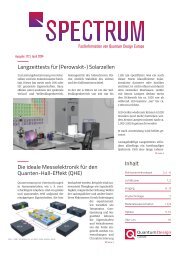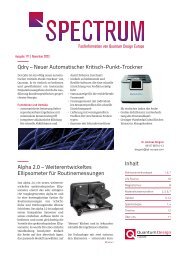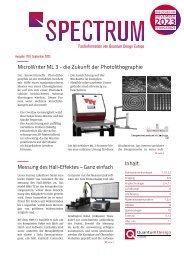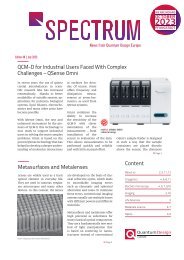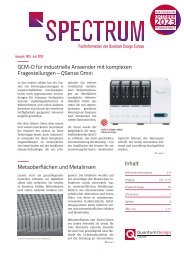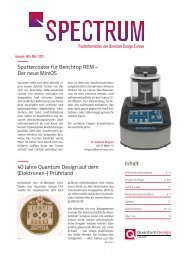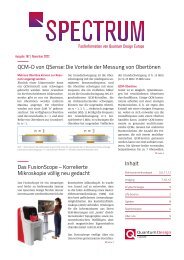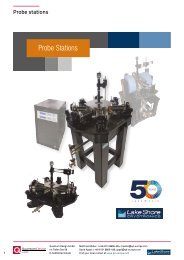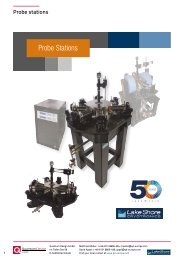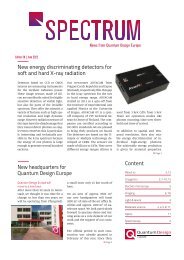Spectrum E39
Create successful ePaper yourself
Turn your PDF publications into a flip-book with our unique Google optimized e-Paper software.
Spectroscopy<br />
Spectroscopy with Fast Repetition Rates<br />
Photosynthesis in plants is the subject<br />
of intensive research. The absorption<br />
of light and its conversion<br />
into energy takes place in accordance<br />
with molecular mechanisms in<br />
pigments or the so-called light-collecting<br />
complexes. Understanding<br />
them is not only a benefit with regard<br />
to our knowledge in the field of<br />
biology, but also helps us with a view<br />
to developing efficient methods of<br />
energy production from sunlight.<br />
A distinction is made between electronic<br />
excitation processes in single<br />
molecules and collective excitations<br />
in aggregated molecules. In the close<br />
surroundings of the pigments, new<br />
electronic energy states are generated,<br />
with allowed and non-allowed<br />
transitions. They are coupled to intra-<br />
and intermolecular vibrations.<br />
These are the cause of the extremely<br />
fast processes on the femtosecond<br />
scale that can be observed. To investigate<br />
these processes, methods<br />
have been developed that enable<br />
changes to be detected in the optical<br />
spectrum of the molecules. In parallel,<br />
ever shorter laser pulses have<br />
become possible, which allows such<br />
phenomena to be studied more closely.<br />
As the time scales of molecular<br />
processes are so short, the Heisenberg<br />
Uncertainty Principle cannot<br />
be ignored, according to which time<br />
and energy cannot be determined<br />
simultaneously with any desired resolution.<br />
2D spectroscopy is the result<br />
of an evolution of pump-probe<br />
spectroscopy, in which information<br />
Andor Marana sCMOS Camera<br />
about the occupation and<br />
transition rates of electronic<br />
energy levels is obtained<br />
at different times. In<br />
this context, "two-dimensional"<br />
means plotting the<br />
signal as a function of the<br />
frequencies of excitation<br />
and emission. There are<br />
several methods based<br />
on this technology, which<br />
are well described in the<br />
publication which is the<br />
basis of this article (1). A<br />
common feature of some of these<br />
methods is that they require spectra<br />
to be recorded at high repetition<br />
rates. Depending on the method of<br />
choice, the spectral information<br />
may be hidden as a minimal variation<br />
on a high background. Making<br />
these weak signals visible requires a<br />
detector with a high dynamic range,<br />
the ratio of pixel capacitance to<br />
readout noise. CCD detectors often<br />
reach their limits here, since the<br />
readout noise (in the denominator)<br />
increases with increasing speed. Increasingly,<br />
sCMOS cameras can be<br />
used as an alternative. They combine<br />
high readout rates with very low<br />
readout noise. Meanwhile, CMOS<br />
sensors with large pixel sizes are<br />
available, in which dynamics, noise<br />
and sensitivity are combined in an<br />
ideal manner. Let us present you<br />
two cameras of this type that have<br />
proven useful for 2D or pump-probe<br />
spectroscopy. The ZYLA-5.5 sCMOS<br />
(Andor Technology) is capable of recording<br />
narrow, 8-lines<br />
spectra at up to<br />
27000 Hz with 15 bit<br />
intensity resolution.<br />
The Marana sCMOS<br />
cameras (Andor Technology)<br />
with their<br />
higher quantum efficiency<br />
enable rates<br />
of up to 11655 Hz<br />
with comparable line<br />
counts and external<br />
triggering. In the<br />
multitrack mode, it<br />
is possible to capture<br />
Principle of 2D spectroscopy. From (1)<br />
spatially separated spectra almost<br />
simultaneously in rapid succession.<br />
The fastest possible recording rate<br />
depends on the number of lines and<br />
their spacing on the sensor. Thus,<br />
several thousand Hz are possible<br />
even for two tracks. As the binning<br />
of CMOS pixels would exceed the 16<br />
bit scale of 65536 AD counts, FPGA<br />
preprocessing has been implemented,<br />
which transfers the added-up<br />
intensity values in 32 bit format to<br />
the computer.<br />
With these features, Andor sCMOS<br />
cameras in conjunction with spectographs<br />
of the Kymera and Shamrock<br />
series provide for a versatility<br />
far beyond that of similar cameras<br />
by other manufacturers. If you are<br />
interested in more information,<br />
please feel free to ask us or discuss<br />
your application with one of our<br />
product managers from the Spectroscopy<br />
& Imaging department.<br />
(1) A. Gelzinis, Ramūnas Augulis, Vytautas<br />
Butkus, Bruno Robert, Leonas<br />
Valkunas; BBA - Bioenergetics 1860<br />
(2019) 271–285<br />
Please contact us<br />
spectroscopy@qd-europe.com<br />
11 <strong>Spectrum</strong>, International edition 39| December 2022




